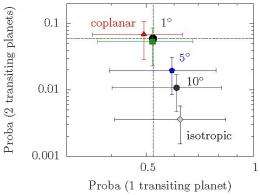Study on extrasolar planet orbits suggests that Solar System structure is the norm

The EXOEarths team (Centro de Astrofísica da Universidade do Porto - CAUP), in collaboration with Geneva University, did a joint analysis of data from the HARPS spectrograph and the Kepler satellite. This analysis revealed that the orbits of other planetary systems are aligned, like in a disk, just like in our own Solar System.
Recently, the HARPS spectrograph and the Kepler satellite made a census of the planetary population around stars like our own, revealing a bounty of planetary systems. A follow-up study lead by members of the EXOEarths team (Centro de Astrofísica da Universidade do Porto - CAUP), in collaboration with Geneva University, did a joint analysis of the data which showed that the planetary orbits in a system are strongly aligned, like in a disk, just as we have in our own solar system.
The two most effective methods for detecting extrasolar planets are the radial-velocity method and the transit method. The radial-velocity method detects planets through the reflex motion induced by the planet on the star's velocity on the radial direction (hence the name). This velocity variation is detected through the Doppler effect, the same that leads to a pitch change in the sound of an traveling ambulance. On the other hand, a planetary transit is akin to a mini-eclipse. As a planet travels around the star, its orbit can locate it in front of the star, and the light we collect from the star is reduced because the planet blocks part of it (even though we cannot image the planet).
There is a significant difference when these two methods are applied to planetary system. A planet can be detected in radial velocity even when the orbit's plane direction is tilted relative to the line of sight, and the same is true for a system of planets. However, for a planet to transit, the plane of its orbit has to be almost perfectly aligned with our lign-of-sight, and the same is true for a system of two (or more planets) to transit. This means that if several planets in a system transit they form necessarily a very small angle between them.
We simulated planetary systems with frequencies as reported by HARPS survey (that detects basically all the systems, independently of their inclination angle), and attributed to them different relative inclinations. The frequency of transiting systems was calculated and compared with the values reported by Kepler. We showed that a match can be obtained for double-transiting systems only if they are very strongly aligned with a common plane (the system's plane). This alignment has to be close to 1 degree, and only reaches 5 degrees on very extreme cases (extreme on the sense of the assumption on how a planetary mass translates to a radius).
These results show consistently that the planets' orbits are predominantly aligned, reinforcing the idea that planets form on a disk and suggesting for the first time that violent encounters between planets are not frequent. This provides a very important clue about the formation and evolution of exoplanets, a domain in which several open questions remain. Even though the solar system's organization is more often the exception than the rule, this study shows that the high degree of alignement of our system might well be the norm.
Pedro Figueira (CAUP), the article's first author stated: “These results show us that the way our Solar System formed must be common. Its structure is the same as the other planetary systems we studied, with all planens orbiting roughly in the same plain.”
More information: P. Figueira, M. Marmier, G. Boué, C. Lovis, N. C. Santos, M. Montalto, S. Udry, F. Pepe, M. Mayor, Comparing HARPS and Kepler surveys: On the alignment of multiple-planet systems, Astronomy & Astrophysics (accepted for publication)
Abstract
Context. The recent results of the HARPS and Kepler surveys provided us with a bounty of extrasolar systems. While the two teams analyzed extensively each of their data-sets, little work has been done comparing the two.
Aims. We study a subset of the planetary population whose characterization is simultaneously within reach of both instruments. We compare the statistical properties of planets in systems with msin i >5-10M⊕ and R>2 R⊕, as inferred from HARPS and Kepler surveys, respectively. If we assume that the underlying population has the same characteristics, the different detection sensitivity to the orbital inclination relative to the line of sight allows us to probe the planets’ mutual inclination.
Methods. We considered the frequency of systems with one, two and three planets as dictated by HARPS data. We used Kepler’s planetary period and host mass and radii distributions (corrected from detection bias) to model planetary systems in a simple yet physically plausible way. We then varied the mutual inclination between planets in a system according to different prescriptions (completely aligned, Rayleigh distributions and isotropic) and compared the transit frequencies with one, two or three planets with those measured by Kepler.
Results. The results show that the two datasets are compatible, a remarkable result especially because there are no tunable knobs other than the assumed inclination distribution. For msin i cutoffs of 7-10M⊕, which are those expected to correspond to the radius cutoff of 2 R⊕, we conclude that the results are better described by a Rayleigh distribution with mode of 1° or smaller. We show that the best-fit scenario only becomes a Rayleigh distribution with mode of 5° if we assume a rather extreme mass-radius relationship for the planetary population.
Conclusions. These results have important consequences for our understanding of the role of several proposed formation and evolution mechanisms. They confirm that planets are likely to have been formed in a disk and show that most planetary systems evolve quietly without strong angular momentum exchanges such as those produced by Kozai mechanism or planet scattering.
Journal information: Astronomy & Astrophysics
Provided by Centro de Astrofísica da Universidade do Porto





















